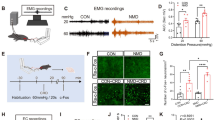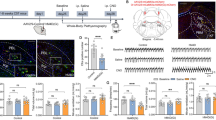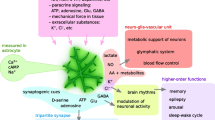Abstract
Rationale
Nitric oxide (NO) is a gas neurotransmitter that may facilitate glutamate release in the central nervous system. NO donors or glutamate agonists injected into the dorsolateral periaqueductal grey (dlPAG) induce flight behaviour.
Objectives
To test the hypothesis that the defensive reactions induced by an NO donor in the dlPAG would be attenuated by pretreatment with AMPA/kainate or NMDA glutamate receptor antagonists.
Methods
Male Wistar rats with cannulae aimed at the dlPAG received vehicle, AP7 (a NMDA receptor antagonist, 2 nmol) or NBQX (an AMPA/kainite receptor antagonist, 100 nmol) injection 10 min before the administration of SIN-1 (an NO donor, 300 nmol). Immediately after the last injection, their behavior was observed in an open arena during 10 min.
Results
SIN-1 induced flight reactions characterized by running and jumps. Pretreatment with AP7 or NBQX completely prevented the effects of SIN-1.
Conclusion
The results suggest that the aversive reactions induced by an NO donor in the dlPAG depend on ionotropic glutamate receptor activation.



Similar content being viewed by others
References
Albin RL, Makowiec RL, Hollingsworth Z, Dure LS, Penney JB, Young AB (1990) Excitory amino acid binding sites in the periaqueductal grey of rats. Neurosci Lett 118:112–115
Bandler R, Carrive P (1988) Integrated defense reaction elicited by excitatory amino acid microinjection in the midbrain periaqueductal grey region of the unrestrained cat. Brain Res 439:95–106
Bandler R, Keay KA, Floyd N, Price J (2000) Central circuits mediating the patterned autonomic activity during active vs. passive emotional coping. Brain Res Bull 53:95–104
Bogdanov MB, Wurtman (1997) RJ Possible involvement of nitric oxide in NMDA-induced glutamate release in the rat striatum: an in vivo microdialysis study. Neurosci Lett 221:197–201
Bredt DS, Snyder SH (1989) Nitric oxide mediates the glutamate-linked enhancement of cGMP levels in the cerebellum. Proc Natl Acad Sci USA 86:9030–9036
Canteras NS, Goto M (1999) Fos-like immunoreactivity in the periaqueductal gray of rats exposed to a natural predator. NeuroReport 10:413–418
Carrive P (1993) The periaqueductal gray and defensive behavior: functional significance and neuronal organization. Behav Brain Res 58:27–47
Chiavegato S, Scavone C, Canteras NS (1998) Nitric oxide synthase activity in the dorsal periaqueductal gray of rats expressing innate fear responses. NeuroReport 9:571–576
Deakin JF, Graeff FG (1991) 5-HT and mechanisms of defense. J Psychopharmacol 5:305–315
De Oliveira RW, Guimarães FS (1999) Anxiolytic effect of methylene blue microinjected into the dorsal periaqueductal gray matter. Braz J Med Biol Res 32:1529–1532
De Oliveira RW, Del Bel EA, Guimarães FS (2000a) Behavioral and c-fos expression changes induced by nitric oxide donors microinjected into the dorsal periaqueductal gray. Brain Res Bull 51:457–464
De Oliveira RW, Del-Bel EA, Mamede-Rosa ML, Padovan CM, Deakin JF, Guimarães FS (2000b) Expression of neuronal nitric oxide synthase mRNA in stress-related brain areas after restraint stress. Neurosci Lett 289:123–126
De Oliveira RW, Del Bel EA, Guimarães FS (2001) Effects of excitatory amino acids and nitric oxide on flight behavior elicited from the dorsolateral periaqueductal gray. Neurosci Biobehav Rev 25:679–685
Edelman GM, Gally JA (1992) Nitric oxide: linking space and time in the brain. Proc Natl Acad Sci USA 89:11651–11652
Feelish M, Ostrowsky J, Noack E (1989) On the mechanisms of NO release form sydnonimines. J Cardiovasc Pharmacol 14:S13–22
Fendt M (2000) Expression and conditioned inhibition of fear-potentiated startle after stimulation and blockade of AMPA/kainate and GABAA receptors in the dorsal periaqueductal gray. Brain Res 880:1–10
Floyd NS, Price JL, Ferry AT, Keay KA, Bandler R (2000) Orbitomedial prefrontal cortical projections to distinct longitudinal columns of the periaqueductal gray in the rat. J Comp Neurol 422:556–578
Garthwaite J (1991) Glutamate, nitric oxide and cell-cell signalling in the nervous system. Trends Neurosci 14:60–67
Garthwaite J, Charles SL, Chess-Williams R (1988) Endothelium-derived relaxing factor release on activation of NMDA receptor suggests role as intercellular messenger in the brain. Nature 336:385–388
Garthwaite J, Garthwaite G, Palmer RMJ, Moncada S (1989) NMDA receptor activation induces nitric oxide synthesis from arginine in rat brain slices. Eur J Pharmacol 172:413–416
Graeff FG (1981) Minor tranquilizers and brain defense systems. Brazil J Med Biol Res 14:239–265
Graeff FG (1994) Neuroanatomy and neurotransmitter regulation of defensive behavior and related emotions in mammals. Braz J Med Biol Res 27:811–829
Guevara-Gusman R, Emson PC, Kendrick KM (1994) Modulation of in vivo striatal release by nitric oxide and cyclic GMP. J Neurochem 62:807–810
Guimarães FS, Carobrez AP, De Aguiar JC, Graeff FG (1991) Anxiolytic effect in the elevated plus-maze of the NMDA receptor antagonist AP7 microinjected into the dorsal periaqueductal grey. Psychopharmacology 103:91–94
Guimarães FS, Aguiar JC, Del-Bel EA, Ballejo G (1994) Anxiolytic effect of nitric oxide synthase inhibitor microinjected into the dorsal central grey. NeuroReport 5:1929–1932
Hall CW, Behbehani MM (1997) The medial preoptic nucleus of the hypothalamus modulates activity of nitric oxide sensitive neurons in the midbrain periaqueductal gray. Brain Res 765:208–217
Hall CW, Behbehani MM (1998) Synaptic effect of enkephalinergic, GABAergic, and glutamatergic networks of the rat periaqueductal gray. Brain Res 805:69–87
Hämälainen MM, Lovick T (1997) Involvement of nitric oxide and serotonin in modulation of antinociception and pressor responses evoked by stimulation in the dorsolateral region of the periaqueductal grey matter in the rat. Neuroscience 80:821–827
Holscher C (1997) Nitric oxide, the enigmatic neuronal messenger: its role in synaptic plasticity. Trends Neurosci 20:298–303
Jenck F, Moreau JL, Martin, JR (1995) Dorsal periaqueductal gray-induced aversion as a simulation of panic anxiety: elements of face and predictive validity. Psychiatry Res 57:181–191
Kano T, Shimizu-Sasamata M, Huang PL, Moskowitz MA, Lo EH (1998) Effects of nitric oxide synthase gene knock out on neurotransmitter release in vivo. Neuroscience 86:695–699
Knowles RG, Palacios M, Palmer RMJ, Moncada S (1989) Formation of nitric oxide from l-arginine in the central nervous system: a transduction mechanism for stimulation of the soluble guanylate cyclase. Proc Natl Acad Sci USA 86:5159–5162
Krieger JE, Graeff FG (1985) Defensive behavior and hypertension induced by glutamate in the midbrain central grey of the rat. Braz J Med Biol Res 18:61–67
Krukoff TL, Khalili P (1997) Stress-induced activation of nitric oxide-producing neurons in the rat brain. J Comp Neurol 377:509–519
Lin HC, Kang BH, Wan FJ, Huang ST, Tseng CJ (2000) Reciprocal regulation of nitric oxide and glutamate in the nucleus tractus solitari of rats. Eur J Pharmacol 407:83–89
Lovick TA (2000) Panic disorder—a malfunction of multiple transmitter control systems within the midbrain periaqueductal gray matter? Neuroscientist 6:48–59
Lovick T, Key BJ (1996) Inhibitory effect of nitric oxide on neuronal activity in the periaqueductal grey matter of the rat. Exp Brain Res 108:382–388
Matheus MG, Guimarães (1997) Antagonism of non-NMDA receptor in the dorsal periaqueductal grey induces anxiolytic effect in the elevated plus maze. Psychopharmacology 132:14–18
Molchanov ML, Guimarães FS (2002) Anxiolytic-like effect of AP7 injected into the dorsolateral or ventrolateral columns of the periaqueductal gray of rats. Psychopharmacology 160:30–38
Montague PR, Gancayco CD, Winn MJ, Marchase RB, Friedlander MJ (1994) Role of NO production in NMDA receptor-mediated neurotransmitter release in cerebral cortex. Science 263:973–977
Ohkuma S, Katsura M (2001) Nitric oxide and peroxynitrite as factors to stimulate neurotransmitter release in the CNS. Prog Neurobiol 64:97–108
Onstott D, Mayer B, Beitz AJ (1993) Nitric oxide synthase immunoreactivite neurons anatomically define a longitudinal dorsolateral column within the midbrain periaqueductal gray of the rat: analysis using laser confocal microscopy. Brain Res 610:3317–3324
Ozawa S, Kamiya H, Tsuzuki K (1998) Glutamate receptors in the mammalian central nervous system. Prog Neurobiol 54:581–618
Paxinos G, Watson C (1997) The rat brain in stereotaxic coordinates, 3rd edn. Academic Press, San Diego
Prast H, Lamberti, C, Fisher H, Tran MH, Philippu A (1996) Nitric oxide influences the release of histamine and glutamate in the rat hypothalamus. Naunyn-Schmiedberg's Arch Pharmacol 354:731–735
Schenberg LC, Marçal LPA, Seebwerger F, Barros MR, Sudré ECM (2000) L-Type calcium channels selectively control the defensive behaviors induced by electrical stimulation of dorsal periaqueductal gray overlying collicular layers. Behav Brain Res 111:175–185
Schenberg LC, Bittencourt AS, Sudré ECM, Vargas LC (2001) Modeling panic attacks. Neurosci Biobehav Rev 25:647–659
Sloan TB (2002) Anesthetics and the brain. Anesthesiol Clin N Am 20:265–292
Snyder SH, Bredt DS (1991) Nitric oxide as a neuronal messenger. Trends Pharmacol Sci 12:125–128
Southam E, Garthwaite J (1991) Comparative effects of some nitric oxide donors on cyclic cGMP levels in rat cerebellar slices. Neurosci Lett 130:107–111
Vargas LC, Schenberg LC (2001) Long-term effects of clomipamine and fluoxetine on dorsal periaqueductal-grey evoked innate defensive behaviours of the rat. Psychopharmacology 155:260–268
Acknowledgements
This research was supported by grants from CAPES, CNPq and FAPESP (02/13197-2). We thank J.C. de Aguiar and E.T. Gomes for excellent technical support.
Author information
Authors and Affiliations
Corresponding author
Rights and permissions
About this article
Cite this article
Moreira, F.A., Molchanov, M.L. & Guimarães, F.S. Ionotropic glutamate-receptor antagonists inhibit the aversive effects of nitric oxide donor injected into the dorsolateral periaqueductal gray of rats. Psychopharmacology 171, 199–203 (2004). https://doi.org/10.1007/s00213-003-1569-9
Received:
Accepted:
Published:
Issue Date:
DOI: https://doi.org/10.1007/s00213-003-1569-9




